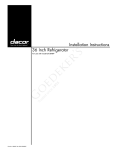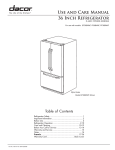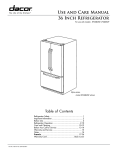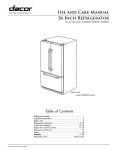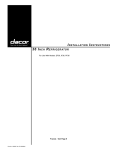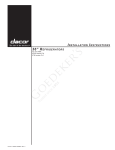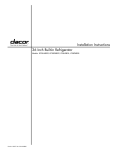Download Dacor EF36BNNF Specifications
Transcript
36 Inch Refrigerator For use with models: EF36BNNF, IF36BNNF Francis - Voir Page 9 Part No. 106177 Rev. D/W10334850 Installation Instructions Table of Refrigerator Safety........................................................................1 Proper Disposal of Your Refrigerator .........................................1 Design Specifications...................................................................2 Product Dimensions.....................................................................2 Installation Specifications.........................................................2-3 Tools and Parts............................................................................ 2 Location Requirements................................................................3 Cabinet Layout.............................................................................3 Water Supply Requirements........................................................ 3 Electrical Requirements...............................................................3 Contents Installation Instructions.............................................................4-8 Unpack the Refrigerator ............................................................. 4 Move Refrigerator into House ....................................................4 Door and Drawer Front Removal................................................4 Reinstalling the Drawer Front...................................................... 5 Reinstalling the Door(s)..............................................................`5 Connecting the Water Supply...................................................... 6 Plug in Refrigerator...................................................................... 7 Move Unit to Final Position..........................................................7 Leveling.......................................................................................7 Handle Installation ...................................................................... 7 Complete Installation...................................................................8 Water System Preparation........................................................... 8 IMPORTANT: • If you receive a damaged product, immediately contact your dealer or builder. Do not install or use a damaged appliance. • Installer: Leave these installation instructions with the homeowner. • Homeowner: Keep these installation instructions for future reference. Save these installation instructions for the local electrical inspector’s use. Customer Service Information If you have questions or problems with installation, contact your Dacor ® dealer or the Dacor Customer Service Team. For repairs to Dacor appliances under warranty, call the Dacor Distinctive Service line. Whenever you call, have the model and serial number of the appliance ready. These numbers are found on a label located on the inside wall of the refrigerator compartment. Dacor Customer Service: Phone: (800) 793-0093 (U.S.A. and Canada) Monday — Friday 6:00 a.m. to 5:00 p.m. Pacific Time Web site: www.Dacor.com Dacor Distinctive Service (repairs under warranty only): Phone: (877) 337-3226 (U.S.A. and Canada) Monday — Friday 6:00 a.m. to 4:00 p.m. Pacific Time All specifications subject to change without notice. Dacor assumes no liability for changes to specifications. © 2009 Dacor, all rights reserved. Refrigerator Safety Your safety and the safety of others are very important. We have provided many important safety messages in this manual and on your appliance. Always read and obey all safety messages. This is the safety alert symbol. This symbol alerts you to potential hazards that can kill or hurt you and others. All safety messages will follow the safety alert symbol and either the word “DANGER” or “WARNING.” These words mean: DANGER WARNING You can be killed or seriously injured if you don't immediately follow instructions. You can be killed or seriously injured if you don't follow instructions. All safety messages will tell you what the potential hazard is, tell you how to reduce the chance of injury, and tell you what can happen if the instructions are not followed. IMPORTANT SAFETY INSTRUCTIONS WARNING: To reduce the risk of fire, electric shock, or injury when using your refrigerator, follow these basic precautions: Plug into a grounded 3 prong outlet. Do not remove ground prong. Do not use an adapter. Do not use an extension cord. Disconnect power before servicing. Replace all parts and panels before operating. Use nonflammable cleaner. Keep flammable materials and vapors, such as gasoline, away from refrigerator. Use two or more people to move and install refrigerator. Remove doors from your old refrigerator. Disconnect power before installing ice maker (on ice maker kit ready models only). Use a sturdy glass when dispensing ice (on some models). SAVE THESE INSTRUCTIONS WARNING Proper Disposal of Your Refrigerator WARNING Suffocation Hazard Remove doors from your old refrigerator. Tip Over Hazard Refrigerator is top heavy and tips easily when not completely installed. Keep doors taped closed until refrigerator is completely installed. Use two or more people to move and install refrigerator. Failure to do so can result in death or serious injury. Failure to do so can result in death or brain damage. IMPORTANT: Child entrapment and suffocation are not problems of the past. Junked or abandoned refrigerators are still dangerous, even if they sit out for “just a few days.” If you are getting rid of your old refrigerator, please follow the instructions below to help prevent accidents. Before you throw away your old refrigerator or freezer: • Take off the doors. • Leave the shelves in place so children may not easily climb inside. 1 Design Specifications Product Dimensions • The depth from the front of the door (w/o door handles) to the back of the refrigerator chassis is 27” (686 mm). • The height from the top of the refrigerator to the floor with the leveling legs in the fully extended position is 71 1/4” (1810 mm) at the front of the unit. Add 2 1/2” (64 mm) for the optional top trim kit (Part # AFG36). • The depth of the cabinet less the door is 24 1/4” (616 mm). • The refrigerator width from edge to edge is 35 5/8” (905 mm). • The power cord is 60” (1524 mm) long. • The height from the top of the refrigerator to the floor with the leveling legs in the down position is 70 1/8” (1781 mm). Add 2 1/2” (64 mm) for the optional top trim kit (Part # AFG36). Installation Specifications Tools and Parts Make sure that you have the necessary tools and materials available for a proper installation: • Phillips screwdriver set Location Requirements Your Dacor refrigerator can be recessed in an opening between cabinets or installed at the end of a cabinet run using a side panel to enclose the refrigerator. WARNING • Slotted screwdriver set • 1/4” (6 mm) copper tubing for the water line. Provide sufficient length to allow for a minimum of a 24” (610 mm) diameter service loop. • Compression nut and compression sleeve to connect to the water supply valve. A compression nut and sleeve are included with the refrigerator to connect the refrigerator side of the line. • Copper tubing cutter • Level - 2’ (0.6 m) and 4’ (1.2 m) recommended • Appliance dolly able to support 700 lbs (317 kg) and adequate manpower to handle the weight of the appliance • Nut driver set or socket set • Crescent wrench Explosion Hazard Keep flammable materials and vapors, such as gasoline, away from refrigerator. Failure to do so can result in death, explosion, or fire. IMPORTANT: • Observe all governing codes and ordinances. • Plywood or cardboard to protect finished flooring • To ensure proper ventilation for your refrigerator, allow for 1/2” (13 mm) space on each side and at the top. Allow for a 1” (25 mm) space behind the refrigerator. • Appropriate materials to cover and protect the home and its furnishings during installation • Do not install the refrigerator in a location where the temperature will fall below 55°F (13°C). • Cordless drill and assorted drill bits • Allow a minimum of 2 1/2” (64 mm) space between the side of the refrigerator and an oven or range. • The floor must be able to support the refrigerator’s weight of more than 600 lbs (272 kg), the door panels and the contents of the refrigerator. • The area to the left and the right of the appliance must permit both doors to open to a minimum of 90°. Allow space between the side of the refrigerator doors and a corner wall for the handle and/or custom door panels. 2 Installation Specifications Cabinet Layout Reverse osmosis water supply • Locate the refrigerator so that it may easily be pulled out from the wall if service becomes necessary. • A grounded three prong non-GFCI electrical outlet must be provided and should be in a location that allows the refrigerator to be connected without an extension cord. See Electrical Requirements for additional information. • The plumbing for the water line can come through the floor flush to or from the back wall. Install the water valve in a location that allows it to be turned off without moving the refrigerator out in the event the refrigerator or water line requires service. • For IF36 series models, see document 100504 for instructions on planning and installing integrated front panels. It is available at www.Dacor.com. 36” Min. (914 mm) IMPORTANT: The pressure of the water supply coming out of a reverse osmosis system going to the water inlet valve of the refrigerator needs to be between 35 and 120 p.s.i. (241 and 827 kPa). If a reverse osmosis water filtration system is connected to your cold water supply, the water pressure to the reverse osmosis system needs to be a minimum of 40 to 60 p.s.i. (276 to 414 kPa). If the water pressure to the reverse osmosis system is less than 40 to 60 p.s.i. (276 to 414 kPa): • Check to see whether the sediment filter in the reverse osmosis system is blocked. Replace the filter if necessary. • Allow the storage tank on the reverse osmosis system to refill after heavy usage. • If your refrigerator has a water filter, it may further reduce the water pressure when used in conjunction with a reverse osmosis system. Remove the water filter. See the use and care manual. Electrical Requirements WARNING 70 ½” Min.* (1791 mm) Suggested electrical location approximate dimensions Electrical Shock Hazard 12” (305 mm) 24” (610 mm) 12” (305 mm) Plug into a grounded 3 prong outlet. Do not remove ground prong. Do not use an adapter. Do not use an extension cord. Failure to follow these instructions can result in death, fire, or electrical shock. *Add 2 1/2” (64 mm) for the optional top gril kit (AFG36). Water Supply Requirements • All installations must meet local plumbing code requirements. A 115 Volt, 60 Hz. AC only 15 or 20 Amp. fused, grounded electrical supply is required. It is recommended that a separate circuit serving only your refrigerator be provided. Use an outlet that cannot be turned off by a switch. Do not use an extension cord. • A cold water supply with water pressure of between 35 and 120 p.s.i. (241 and 827 kPa) is required to operate the water dispenser and ice maker. If you have questions about your water pressure, call a licensed, qualified plumber. • Install a shut off valve between the refrigerator and water supply. Use 1/4” copper tubing with a compression nut and compression sleeve and check for leaks. Allow a minimum of 24” (610 mm) diameter service loop of copper tubing outside the wall or floor for easy connection to the water supply. Install copper tubing only in areas where the household temperatures will remain above freezing. • Do not use a piecing type or 3/16” (5 mm) saddle valve which will reduce water flow and clog more easily. If you have questions about your water pressure, call a licensed, qualified plumber. 3 Installation Instructions IMPORTANT: Read all directions before you begin. Unpack the Refrigerator WARNING 1. Place an appliance dolly under the left side of the refrigerator as shown. Be sure to avoid damaging the side trims and handles. Place the corner posts from the packing materials over the trims and handles as appropriate. Slowly tighten the strap. NOTE: Pass the dolly strap under the handles for EF36 and PF36 series models. Tip Over Hazard Refrigerator is top heavy and tips easily when not completely installed. Keep doors taped closed until refrigerator is completely installed. Use two or more people to move and install refrigerator. Failure to do so can result in death or serious injury. IMPORTANT: • Do not remove the film on the outside until the refrigerator is in its operating position. • Remove tape and glue residue from surfaces before turning on the refrigerator. Rub a small amount of liquid dish soap over the adhesive with your fingers. Wipe with warm water and dry. • Do not use sharp instruments, rubbing alcohol, flammable fluids or abrasive cleaners to remove tape or glue. These products can damage the surface of your refrigerator. For more information, see Important Safety Instructions. 2. Place pieces of the shipping carton on the floor when rolling the dolly and refrigerator into the house. Move the refrigerator close to the opening. 3. Place cardboard or plywood under refrigerator. 4. Stand the refrigerator up. First, place the left bottom edge of the refrigerator on the floor, stand the refrigerator upright and then lower the right-hand side of the refrigerator to the floor. Door and Drawer Front Removal WARNING • Dispose of/recycle all packaging materials. • After you remove all of the packaging materials, clean the inside of your refrigerator before using it. See Care and Cleaning in the use and care manual. Move Refrigerator into House WARNING Electrical Shock Hazard Disconnect power before removing doors. Failure to do so can result in death or electrical shock. Some installations require door and drawer front removal before transporting the refrigerator through doorways to the location where it will be used. 1. Unplug the power cord from the power source. Tip Over Hazard Refrigerator is top heavy and tips easily when not completely installed. Keep doors taped closed until refrigerator is completely installed. Use two or more people to move and install refrigerator. Failure to do so can result in death or serious injury. 4 2. Remove the toe grille. Installation Instructions 3. Remove the top hinge cover from the refrigerator door by removing the Phillips screw. Retain the screw and cover for later use. Hinge style may vary. 4. Unscrew the 5/16” hex head screws from the top hinge. Remove the hinge and retain it and all screws for later use. 5. On 3 door (french door) models, disconnect the wiring plug located on top of the left top hinge by wedging a flat-blade screwdriver between the two sections. Hinge cover the Door(s) After the moving the refrigerator to the location where it will be used, reinstall the door(s) and freezer drawer front. 1. Replace the rollers. Top hinge Wiring plug 2. Slide the screws on the back of the drawer front into the slots in the drawer brackets on both sides. You may need to move the bottom of the bracket around slightly to get the slot to line up with the screw. 3. Tighten the four front panel screws completely. Do not over-tighten. 6. Lift the refrigerator door(s) from the center hinge pin. 7. Remove the Phillips screws that hold the center hinge in place. Remove the hinge and retain it and all screws for later use. Reinstalling 4. Install the top hinge loosely using the existing 5/16” hex head screws. 5. Install the center hinge using the existing Phillips screws. Center hinge Top hinge Center hinge 8. Pull the freezer drawer completely open. 9. Loosen the four (4) screws attaching the drawer brackets to the drawer front as shown. NOTE: Loosen the screws only three to four turns. Do not remove the screws from the drawer front. 6. Place the hinge side of the refrigerator door on the center hinge pin. 7. While holding the refrigerator door upright, tighten down the top hinge with a 5/16” hex head driver. Hinge pin 8. On 3 door (french door) models, reconnect the wiring plug located on top of the left top hinge. 10. Lift the drawer front upward and off the screws. 11. Unscrew the hex head screws from the rollers and remove. Wiring plug 9. Replace the top hinge cover using the existing Phillips screw. Hinge cover 5 Installation Instructions Connecting the Water Supply 1. Unplug the refrigerator from the electrical outlet. 2. Create a service loop with copper tubing (minimum 2 foot /61 cm diameter). Avoid kinks in the copper tubing when bending it into a service loop. Do not use plastic tubing. Min. 2’ diameter (not to scale) 6. Slide the brass nut over the sleeve and screw it into the inlet port. 7. Place an adjustable wrench on the nut attached to the plastic waterline. Maintain position. 8. Using a second adjustable wrench, turn the lower nut counterclockwise and fully tighten it while holding the upper nut in place. Do not overtighten. Copper tubing 3. Remove the plastic cap from water valve inlet port. 9. Pull on the tubing to confirm the connection is secure. Connect the tubing to the frame with the water tubing clamp. “P” clamp 4. Place the brass nut and sleeve on the end of the copper tube as illustrated. The nut and sleeve are provided in the use and care packet. Do not use an old sleeve. Compression sleeve Compression nut 5. Place the end of the copper tubing into the water valve inlet port. Shape the tubing slightly. Do not kink the tubing so that it feeds straight into the inlet port. Compression sleeve Compression nut 6 10. Turn on the water supply. Check for leaks and correct if necessary. Continue to observe the water supply connection for two to three hours prior to moving the refrigerator to its permanent location. Monitor the water connection for 24 hours. Correct leaks if necessary. Installation Instructions Plug in Refrigerator WARNING Electrical Shock Hazard Plug into a grounded 3 prong outlet. Do not remove ground prong. Do not use an adapter. Leveling WARNING Tip Over Hazard Refrigerator is top heavy and tips easily when not completely installed. Keep doors taped closed until refrigerator is completely installed. Do not use an extension cord. Use two or more people to move and install refrigerator. Failure to follow these instructions can result in death, fire, or electrical shock. Failure to do so can result in death or serious injury. Plug the refrigerator into a grounded three prong outlet. Move Unit to Final Position WARNING 1. Remove the base grille. Grasp the grille firmly an pull it toward you. 2. Having someone push against the top of the refrigerator takes some weight off the leveling screws. Doing so makes it easier to turn the screws. • To raise, turn the leveling screw clockwise. • To lower, turn the leveling screw counterclockwise. Tip Over Hazard Refrigerator is top heavy and tips easily when not completely installed. Keep doors taped closed until refrigerator is completely installed. Use two or more people to move and install refrigerator. Failure to do so can result in death or serious injury. IMPORTANT: To avoid floor damage, make sure the levelers are raised (not touching the floor) and the refrigerator is on the rollers before moving. 1. Place cardboard or plywood under the refrigerator. Remove the dolly. 2. Move the refrigerator straight back, evenly into the opening. Be sure that the refrigerator side trims are not interfering with the door opening. Also, be sure that the water tubing is not kinked and the power supply cord is on top of the refrigerator. 3. Open the door again to make sure that it closes as easily as you like. If not, tilt the refrigerator slightly more to the rear by turning both adjustments screws clockwise. It may take several more turns, and you should turn both adjustment screws the same amount. 4. Replace the base grill. Handle Installation • Some units do not come with the handle installed to allow the customer to choose the handle style. Optional handle kits are also available. See the use and care manual for a list of available handle kits. • The installation instructions for the handle are included with the kit. 7 Installation Instructions Complete Installation 1. Turn the water supply line valve to the open position. 2. Wait a few minutes. Check the water line connections for leaks. 3. Remove all boxes, parts packages and packing materials from the interior of the refrigerator. 4. Remove the film and cardboard from the grille and doors or door frame, depending on your model. 5. Install the shelves and bins in the refrigerator and freezer compartments. 6. The controls are preset at the factory to the midpoint setting. Check that the compressor is operating properly and that all the lights are working. 7. Flush the water system before use. See Water System Preparation. To get the most efficient use from your new refrigerator, read your use and care manual. Keep these installation instructions and the use and care manual near the refrigerator for easy reference. Water System Preparation Please read before using the water system. Immediately after installation, follow the steps below to make sure that the water system is properly cleaned. NOTICE: Flush four (4) gallons of water through the water filter cartridge before use. Allow 24 hours for the refrigerator to cool down and chill water. Do not use with water that is microbiologically unsafe or of unknown quality without adequate disinfection before or after the system. Systems certified for cyst reduction may be used on disinfected waters that may contain filterable cysts. 1. Install the water filter. The water filter is located in the upper right hand corner of the fresh food compartment. Remove the blue bypass cap and retain it for later use. Remove the sealing label from the end of the filter and insert it into the filter head. Rotate it gently clockwise until it stops. Snap the filter cover closed. 2. Hold a sturdy container under the water spout and press the dispenser button. Flush the water system by dispensing and discarding 4 gallons (15 L) of water. Cleaning the system will take approximately 5 minutes and will help clear air from the line. Additional flushing may be required in some households. As air is cleared from the system, water may spurt out of the dispenser. 8 3. Make sure the ice bin is in place and the ice maker arm is down. 4. After the freezer section reaches between 0° to 2°F (-18° to -17° C), the ice maker fills with water and begins operating. You will have a complete harvest of ice approximately every three hours. 5. Allow approximately 24 hours after installation to receive the first harvest of ice. 6. Discard ice created within the first 12 hours of operation to assure the system is flushed of impurities. Dacor ● 600 Anton Blvd. Suite 1000 Costa Mesa, CA 92626 ● Phone: (800) 793-0093 ● Fax: (626) 403-3130 ● www.Dacor.com













